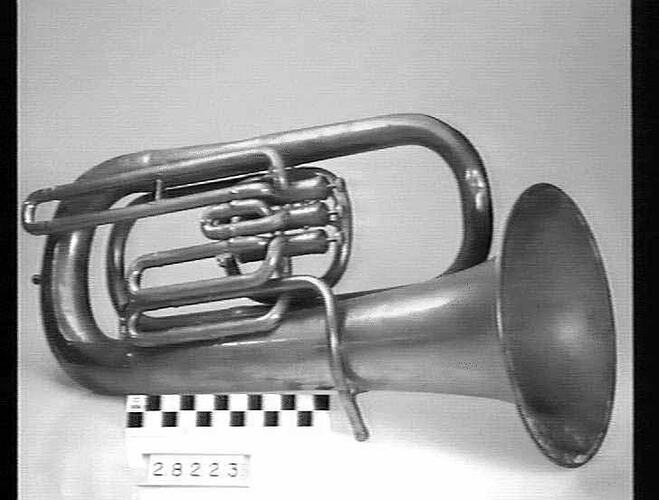Summary
Alternative Name(s): Tenor Tuba
Brass euphonium, made in England some time between 1874 and 1930 by Boosey & Co. The euphonium was donated to Museums Victoria in 1963.
In 1868, the established music publisher Boosey & Co. acquired the Henry Distin company, which introduced saxhorn instruments to England and designed innovative brass instruments. In 1874 Boosey & Company moved into offices at 295 Regent Street - the address marked on this instrument. In 1930 Boosey & Co. merged with Hawkes & Son - the two rival firms had been significant in shaping wind instrument playing in Britain since the mid-19th century. During World War II, the Boosey & Hawkes factory in Edgware was requisitioned to manufacture components for Lancaster bombers and Spitfire fighters (Strauchen-Scherer, 2006).
Developed in the late 1830s-early 1840s, the euphonium is pitched in concert B flat. It is typically used as a band instrument; it is less commonly used in orchestras. The euphonium's large range and technical capacity also make it well-suited to jazz solos; the euphonium also doubles on a trombone part in jazz combos. A jazz euphonium niche has been developing since around the 1970s; Rich Matteson played a leading role in its development. Jazz euphoniums are most common in tuba-euphonium groups; modern funk or rock bands occasionally use a brass player doubling on a euphonium.
Physical Description
Brass euphonium with 3 valves numbered 15, 14, 13 on the middle valve.
More Information
-
Collecting Areas
-
Acquisition Information
Purchase
-
Maker
-
Inscriptions
Marked: CLEAR BORE TRADE MARK BOOSEY (IN DIAGRAM OF BUGLE) BOOSEY & CO MAKERS 295 REGENT ST LONDON 84613. Marked: TRADE MARK BOOSEY (IN BUGLE) 67763.
-
Classification
-
Category
-
Discipline
-
Type of item
-
Overall Dimensions
78 cm (Length), 46 cm (Width)
-
References
Dr Bradley Strauchen-Scherer (Department of Musical Instruments at the Metropolitan Museum of Art), 2006. Sound Designs: the story of Boosey & Hawkes Gallery exhibition catalogue, Horniman Museum 2006. 'Boosey & Hawkes', wikipedia [Link 1] accessed 4/6/2019. 'Euphonium', wikipedia [Link 2] accessed 4/6/2019.
-
Keywords
Brass Instruments, Musical Instruments, Tubas, Wind Instruments, Jazz Music
